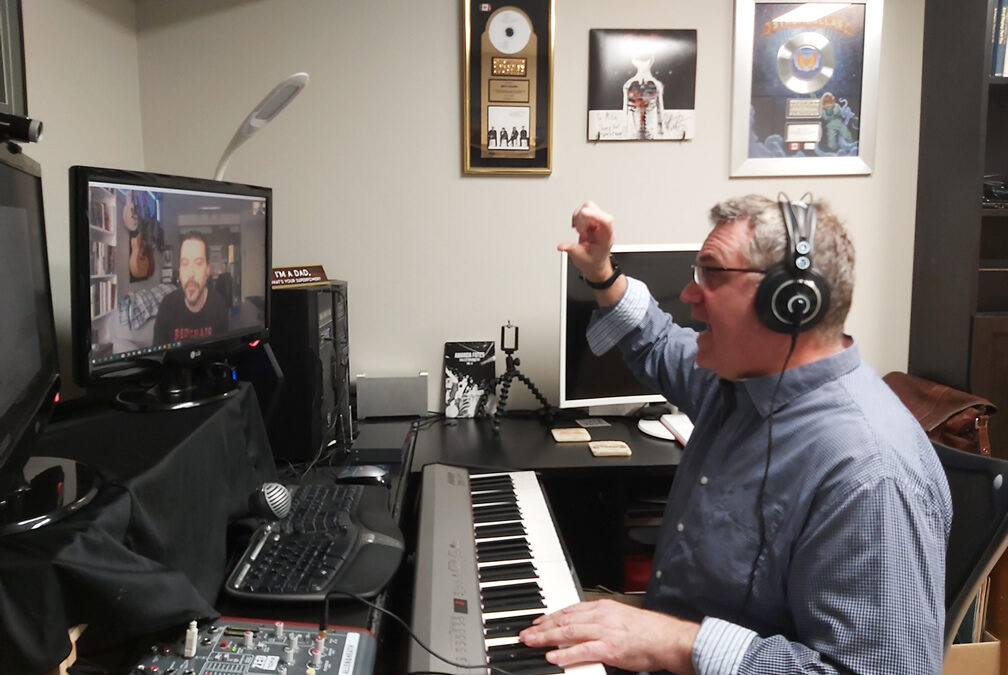Photo: Mitch working with Adam Wilson from Red Chair.
Want to learn more about how to warm up the voice?
I’ll answer some questions about how and why you should warm up before a gig, a recording session or a rehearsal.
Hi, I’m Mitch Seekins – The Vocal Coach and have been teaching recording artists, touring artists and regular people how sing , maintain, and even repair damaged voices so they can look forward to a less stressful and a much longer career. I performed and toured myself, singing many different genres of music for 37 yrs., so was able to develop and test all kinds of warm up methods. The following is what I teach my students!
- Warming up is a key factor for a vocalist before any event. Getting the muscles moving, the blood flowing to the area, knocking gunk off the cords, is the best way to ensure your top performance and lessen the chance of hurting the voice.
- As a vocal coach I guide singers how to not only develop and strengthen their voices but also how to maximize what they have at any given time, This includes being at the top of their game and healthy, as well as…not being at the top of their game and dealing with vocal fatigue, swollen vocal chords or being just plain sick!
- I do get questions regarding how to vocally warm up properly. As a student of mine, once the fundamentals are established, I create warm up files specifically for everyone. This includes warmup exercises that pertain to the level they are at as well as their specific vocal range and abilities. Obviously, I can’t do that here for you, but I can share some simple exercises for common ranges and at least get you started on the right track!
Some of the questions I get are:
How long should I warm up for?
- I have always viewed singing as an athletic event. If you imagine yourself as an athlete, you can often rationalize how to approach things. A top-level athlete will ALWAYS warm up before a competition. This ensures that the body’s muscles are warm, have all the kinks worked out and are ready to perform. They would never warm up to the point where it becomes a “workout”. You should never waste the energy you need for peak performance. The goal is to get the muscles prepped for peak performance!
- From a singer’s standpoint, it’s the same. Unless you’ve begun the process of getting everything moving how could you ever expect to perform at your best? For a vocalist in today’s music business, being in top form and consistent is a must!
- What I have found to work best, is a warmup lasting 10 to 15 min, that should end approx. 20 to 30 min prior to the show. Having a short rest after a vocal warm up is important as it allows the muscles to relax and if there is any residual phlegm left, time for it to clear. Like any pro athlete you need to work that into a pre-performance habit, so it is always done.
What do I need to warm up? Chest voice, Head voice or Falsetto…. or all of it?
All of it. All parts of the voice are used in producing a good quality sound for a show. Therefore, you need to stretch all aspects of your voice out!
Is there one exercise that does it all for me?
- No. But there is one that comes close! It’s called “Lip Trills”. These exercises have been around for a VERY long time. I have the very first book ever written on vocal technique by Pier Francesco Tosi…in 1743! He talks about them in the book. Who knows how long they were around before that? He doesn’t claim to have invented them, just that they are an integral part to any vocal warm up for any voice type.
- It’s a fantastic exercise that works through all the registers in the voice (chest and head or falsetto), forcing you to relax while doing it, because if you get any tongue, jaw, throat or torso tension, the exercise stops working!
- It begins the process of learning to properly negotiate the passagio, or that “crack” we all have between the chest voice and the head voice. It’s not the be all and end all of learning how to do that, but it a great way to start.
- It stretches out all the resisters (Chest and Head) from the very bottom to the very top of your range, working the muscles and getting the blood and warmth to flow.
- It begins the process of moving any phlegm off the vocal cords
- It establishes good vocal placement, as you can’t do them in the back of the throat
- Overall a great way to start a warmup!
Can you do them wrong?
- Yes. However, they are very easy to learn to do right…to the point that afterwards, it’s difficult to do them wrong! I will be filming examples of how you should approach them. If you don’t get them right immediately, have no fear. It’s only a matter of a little time for the cords to shift into the proper position and in the meanwhile, as a warmup, they still work great!
Do I really need to do this? Usually I just go out and scream my face off! Seems to work for me!
- Ummm…yeeaahh… good luck with that. You can’t expect that to work for long. Aging is a bitch… and there is no avoiding it. When it comes to vocal recovery after a show, (many of my students sing extremely aggressive shows in front of THOUSANDS of fans at a time) it simply takes time. And the older you get, the more time it takes! Think about the aging athlete. Warming up beforehand really helps in your ability to NOT hurt the voice during a performance. Successful artists take care of their instruments so they can enjoy long careers.
So, there is a basic overview of vocally warming up and why you need to do it! What I’m going to do is give you is a free sample of my warmup files that I produce for my students. This will be a “generic” arpeggio pattern that you can either stream or download for you to use. Personally, I would download them as then you would never get caught if at a gig the internet signal is weak. Just put it on your phone, plug in one ear bud (use your other ear to hear yourself!) and go to work!
- If you find the starting point too low or the top notes too high for your range just wait until the notes come around that work for you. The file I’m sharing is a common range file that should work for about 95% of you. There will be one file for the male voice and one for the female voice.
- Throughout the file not only will I be playing the notes to trill to, I will also be “coaching” you on what to think or visualize while you run through the scales.
Be sure to check out my YouTube Channel “The Vocal Coach” for more tips and files!
Email Mitch to get started


